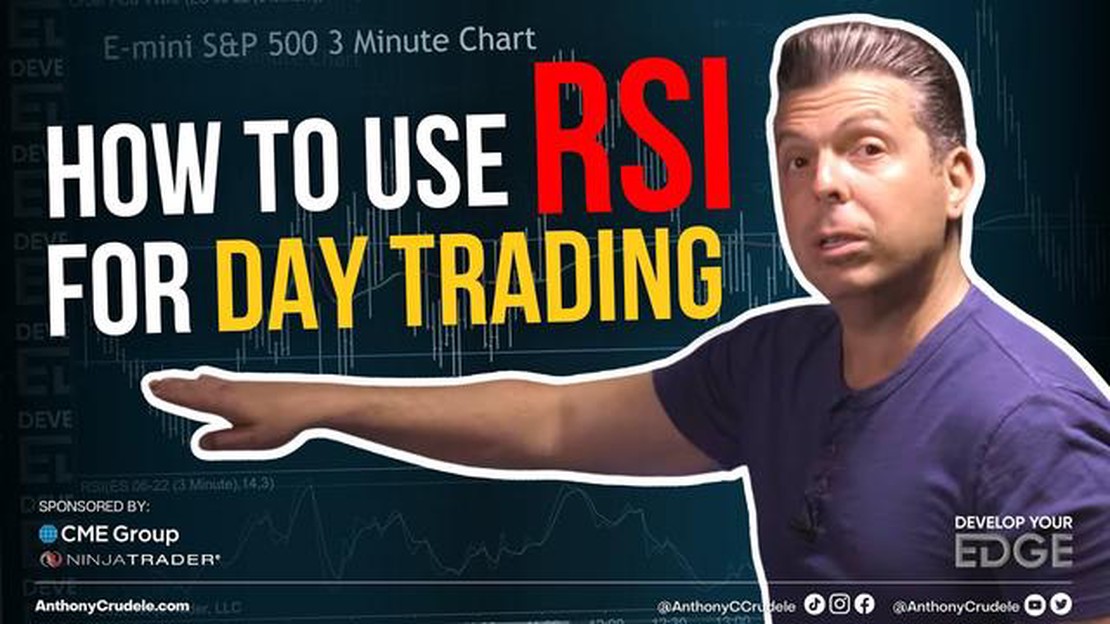Understanding the CFA Swap Rate: An Essential Guide for Traders and Investors
Understanding the CFA Swap Rate: A Comprehensive Guide When it comes to trading and investing, understanding the CFA Swap Rate is essential. This …
Read Article
The Relative Strength Index (RSI) is a popular technical indicator used by traders to analyze the strength and weakness of a particular asset. It is a momentum oscillator that measures the speed and change of price movements. In intraday trading, where traders make trades within the same day, the RSI can provide valuable insights into market conditions and help make informed trading decisions.
One of the main advantages of using the RSI indicator for intraday trading is its ability to identify overbought and oversold conditions. When the RSI is above 70, it indicates that the asset is overbought and may be due for a reversal or correction. Conversely, when the RSI is below 30, it suggests that the asset is oversold and may be due for a bounce back. This information allows traders to enter or exit positions at optimal levels, potentially maximizing profits and minimizing losses.
Another benefit of the RSI indicator is its ability to confirm trends. By analyzing the RSI trend along with price action, traders can determine the strength of a trend and make more accurate predictions. For example, if the RSI is trending upwards while prices are also rising, it suggests a strong uptrend. Conversely, if the RSI is trending downwards while prices are falling, it indicates a strong downtrend. This confirmation can help traders avoid false signals and improve the overall accuracy of their trades.
However, like any technical indicator, the RSI has its limitations and drawbacks. One of the main disadvantages is its tendency to generate false signals during periods of consolidation or low volatility. In such situations, the RSI may give misleading indications of overbought or oversold conditions, resulting in losses for traders. It is important to consider other factors and indicators when using the RSI and not rely solely on its signals.
In conclusion, the RSI indicator can be a valuable tool for intraday traders, providing insights into overbought and oversold conditions and confirming trends. However, it is important to use the RSI in conjunction with other technical analysis tools and consider the overall market context. Traders should also be aware of the limitations of the RSI and interpret its signals with caution. With the right approach and proper understanding, the RSI can be a useful addition to an intraday trading strategy.
The Relative Strength Index (RSI) indicator is a popular tool used by many day traders to identify potential trading opportunities. While it can be a valuable tool, it is important to be aware of both the advantages and disadvantages of utilizing the RSI indicator in day trading.
Advantages:
1. Trend identification: The RSI indicator helps traders identify the underlying trend in a security. By analyzing whether the RSI is above or below certain levels, traders can determine if the market is in overbought or oversold conditions, potentially signaling a reversal in the trend.
2. Entry and exit points: The RSI indicator can be used to determine entry and exit points for trades. For example, when the RSI crosses above a certain level, it may indicate a buy signal, while a cross below a certain level may indicate a sell signal.
3. Confirmation tool: The RSI indicator can be used as a confirmation tool to validate other technical analysis signals. For example, if a trader identifies a potential trend reversal based on a price pattern, they can use the RSI indicator to confirm the strength of the reversal signal.
Disadvantages:
1. False signals: One of the main disadvantages of the RSI indicator is its tendency to generate false signals. The indicator can give false readings in certain market conditions, leading to poor trading decisions.
2. Lagging indicator: The RSI indicator is a lagging indicator, meaning it reacts to price movements that have already occurred. This can result in delayed signals and missed trading opportunities.
3. Overreliance: Relying too heavily on the RSI indicator can lead to overtrading or missing out on other important aspects of technical analysis. It is important to consider other indicators and factors when making trading decisions.
Read Also: Is IBKR a Good Choice for Beginners? - Learn More Here
In conclusion, while the RSI indicator can be a valuable tool in day trading, it is important to consider both its advantages and disadvantages. Traders should use the RSI indicator as part of a comprehensive trading strategy and not rely solely on its signals.
The Relative Strength Index (RSI) indicator is a popular technical analysis tool used by intraday traders to identify overbought and oversold conditions in the market. This indicator provides several advantages when incorporated into intraday trading strategies.
Read Also: How much BGN is 2000 USD? - Currency exchange rate calculator
 5. Useful for Range-Bound Trading: Intraday traders who specialize in range-bound markets can benefit from incorporating the RSI indicator into their trading strategies. The RSI can help traders identify periods of consolidation and anticipate breakouts or breakdowns, enabling them to take advantage of these price movements.
5. Useful for Range-Bound Trading: Intraday traders who specialize in range-bound markets can benefit from incorporating the RSI indicator into their trading strategies. The RSI can help traders identify periods of consolidation and anticipate breakouts or breakdowns, enabling them to take advantage of these price movements.
Overall, the RSI indicator provides valuable insights and signals for intraday traders. However, it is essential to combine the RSI indicator with other technical analysis tools and consider other factors such as market conditions, news events, and risk management strategies to make well-informed trading decisions.
The RSI (Relative Strength Index) is a popular technical indicator used in trading to measure the strength and speed of a price movement. It helps traders determine if an asset is overbought or oversold and can be used to generate trading signals.
The RSI indicator compares the average gain and average loss over a specified period of time to calculate a value between 0 and 100. A value above 70 usually indicates that an asset is overbought and due for a price correction, while a value below 30 suggests that it is oversold and may see a price bounce.
Using the RSI indicator can help traders identify potential trend reversals and generate buy or sell signals. It can also provide confirmation for other technical analysis tools and help traders avoid entering trades when the market is overbought or oversold.
While the RSI indicator can be a useful tool, it is not without its limitations. It can generate false signals, especially in a sideways or ranging market. Additionally, the RSI indicator alone should not be relied upon as the sole factor for making trading decisions.
The RSI indicator is commonly used for short-term and intraday trading due to its ability to identify overbought and oversold conditions in the market. However, it can also be applied to long-term trading strategies as a confirmation tool when used in conjunction with other technical indicators and analysis methods.
The RSI indicator, or the Relative Strength Index, is a popular technical indicator used in trading to determine overbought or oversold conditions of an asset. It calculates the ratio of the average gains to the average losses over a specific period of time, typically 14 days. The RSI ranges from 0 to 100 and is typically plotted as a line graph. Traders use the RSI to identify potential entry and exit points in the market.
There are several advantages of using the RSI indicator for intraday trading. Firstly, it helps traders identify overbought and oversold levels, which can be used to anticipate potential reversals in the market. Secondly, the RSI can provide early signals of trend changes, allowing traders to make timely decisions. Additionally, the RSI can be used to confirm other technical indicators and increase the probability of successful trades.
Understanding the CFA Swap Rate: A Comprehensive Guide When it comes to trading and investing, understanding the CFA Swap Rate is essential. This …
Read ArticleWill the Australian Dollar Rise or Fall? Is the Australian Dollar Likely to Strengthen or Weaken? The Australian dollar, also known as AUD, has been …
Read ArticleTop Forex Trading Opportunities for Today In the ever-changing world of foreign exchange, it is crucial for traders to keep up with the latest trends …
Read ArticleHow to Set Stop Loss and Take Profit? When it comes to trading in the financial markets, managing risk is essential. One of the most effective ways to …
Read ArticleJapanese 1 yen coin exchange rate in Philippines The exchange rate between the Japanese 1 yen coin and the Philippine peso is an important indicator …
Read ArticleCalculating Strike Price for ESOP: A Comprehensive Guide Employee Stock Ownership Plans (ESOPs) are a popular way for companies to provide ownership …
Read Article